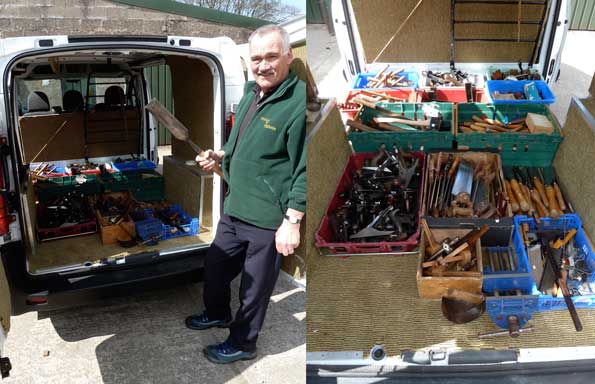We had an unexpected visitor to the workshop on friday. Every once in a while The Toolman stops by to say hello and show off his spoils. I have only met him a handful of times, but he's a fascinating character. Travelling the length and breadth of the country visiting auctions, John has a vast collection of antique tools of all shapes, sizes, uses and ages. Most of what he buys and sells he knows the history or the previous owner. I was privileged to visit him at his home last month and the collection doesn't stop at his van, it is clearly a worthwhile passion of his...

This week he had two boxes of hammers, only a fraction of the 360 hammers he won at the last auction he attended. As you do.
Seeing a selection of hammers really demonstrates the incredible variety one instrument can have for doing a number of different jobs. Hammers do so much more than bang things. The shapes, weights and sizes all depend on the job. This one pictured is a roof tilers hammer, it's quite lightweight, well used and beautiful.
During my time at the Workshop I have really developed an appreciation of hand tools, their design, history and how to use them properly. Antique tools aren't too dissimilar to the pieces of furniture they help create. They are specific to the owner's needs. A new handle is turned especially. The weight of the tool in your hand should feel right. The sound the tool makes on the wood tells you so much about the wood, as well as the tool. The blade is honed and sharpened time and again throughout each project, slowly altering the shape a fraction of a millimetre at a time. Each time you sharpen your tool, the better you know it, the more automatic the actions become. Both the tool and the craftsman mould to each other over time. Improving with time.
Sifting through The Toolman's collection there are years of peoples lives. All sorts of names stamped in boxwood handles. Patches of worn metal were the previous owner has held this plane or that chisel again and again, always in the same spot. Blades only a few centimetres long, the rest has been sharpened away after a long career.
The first thing you need to look for when tool shopping is the stamped emblems of the steel manufacturer. This is were antique tools are far and beyond the best tools for the job, because back in the day the blades were made with better, purer steel. It might take a lot of hard work and time to get them back down to working condition, but when you do it's worth it. The quality of the steel is vital for keeping a sharp edge for longer and providing cleaner cuts to the wood. 
If you would like to get in touch with John, let me know. I'm sure he will be ever so happy to talk tools. Gather up your questions because there isn't much he doesn't know. I have also been meaning to do a blog post about Huw's incredible tool chest. Watch this space for that update.
